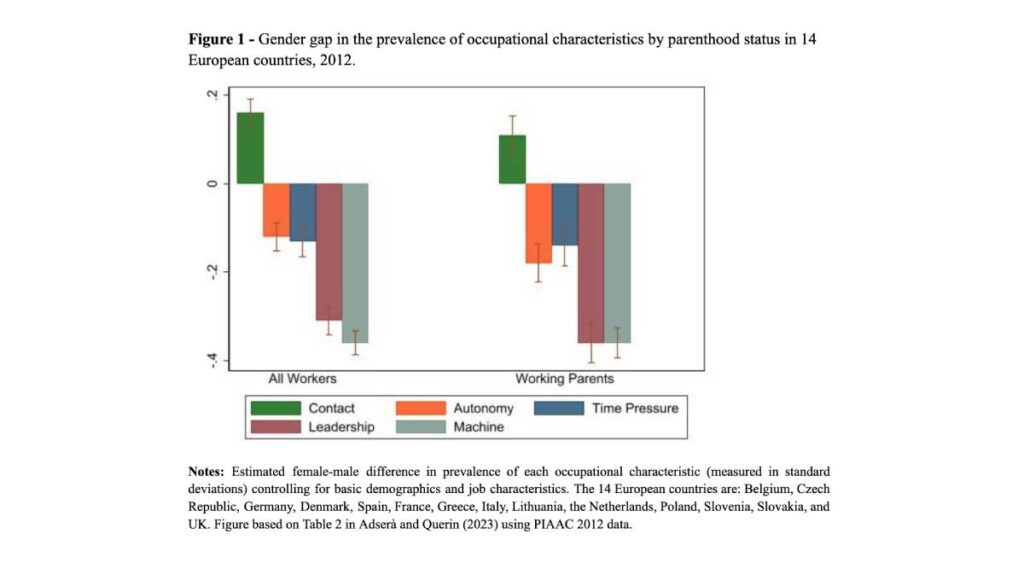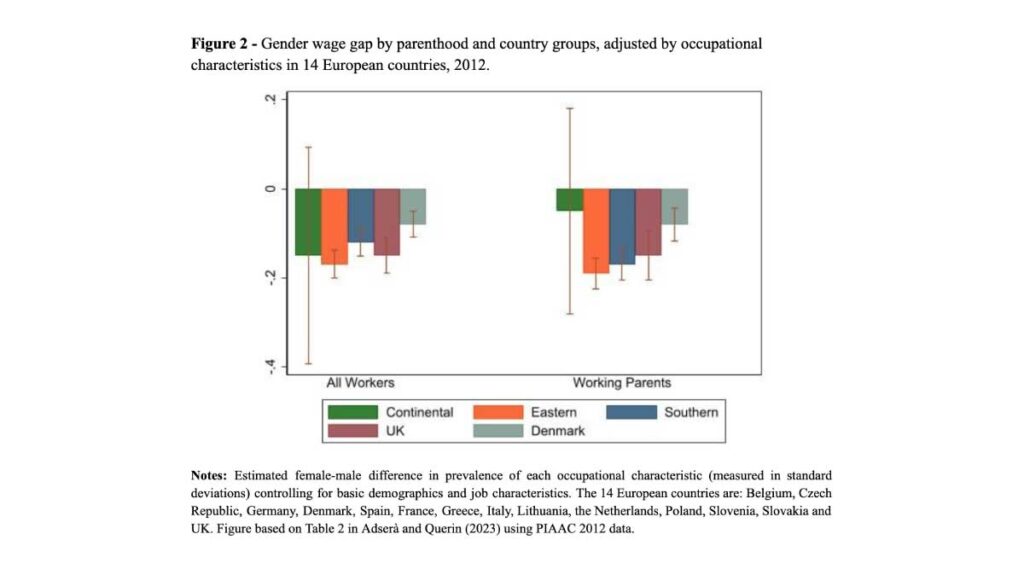The gender wage gap persists, especially among mothers. Alícia Adserà and Federica Querin show that despite low wages in predominantly male occupations that depend on heavy machinery, women (and chiefly mothers) are penalized by holding fewer jobs with leadership roles and more jobs that require frequent contact with others.
Despite important advances in closing the gender wage gap in most advanced countries over the last decades, progress has slowed or stalled during recent years. As women’s educational attainment now often surpasses that of men, explanations for the persistence of this gap point to gender-based differential sorting into sectors, and sorting on occupational characteristics within each sector (Goldin 2014; Blau and Khan 2017). Gendered occupational sorting increases in saliency for parents, who must juggle work and family demands.
In a recently published paper, we used data across 14 countries from the Program for the International Assessment of Adult Competencies (PIAAC), collected by the OECD in 2012, to examine the degree of sorting on occupational characteristics and its implications for the gender wage gap, with a focus on parents (Adserà and Querin 2023). For each individual, we matched occupational characteristics at 4-digit ISCO-08 codes with information from the O*NET database on the requirements and work content of occupations. We examined five occupational characteristics relating to the importance of interpersonal relationships in the job, the worker’s autonomy, and a time component. Each index is normalized to have mean of zero and a standard deviation of one.
Prevalence of occupational characteristics is gendered
• The first occupational characteristic is contact with others, which is defined by frequent interactions with peers such as colleagues, clients, and the public. It is closely linked with flexibility and ability to work from home, occupational characteristics that increased in relevance during the COVID-19 pandemic.
• The second, leadership, captures vertical hierarchical work relationships and involves guiding, directing, and coordinating other workers. Unlike contact with peers, leadership is associated with higher wages and, in general, tends to be male-dominated.
• Third, autonomy is defined as having a job characterized by control on the decision-making process. It is juxtaposed with machine-dependency, which involves the direct operation of machinery and vehicles that require the worker’s physical presence at the workplace. These latter occupations are frequently performed by men but, unlike most predominantly male occupations, often do not reap high wage returns.
• Lastly, time pressure and high frequency of deadlines captures the time squeeze that may be especially binding for parents.
Figure 1 shows that the gender differences (in standard deviations) in prevalence for the five occupational characteristics align with expectations. Only contact with others is, on average, more prevalent in jobs held by women, while machine use and leadership are much more prevalent in men’s jobs. In general, when we restrict the sample to parents, gender differences amplify. This is particularly evident in the increased gap between mothers and fathers in occupations with more autonomy and leadership. For example, mothers’ occupations are associated with 0.30 standard deviations fewer leadership requirements than fathers, while this difference increases to 0.36 standard deviations fewer among childless individuals.

While there is no difference in machine use between fathers and childless men, it is fathers who most frequently hold leadership roles, in line with previous research on the existence of both a glass ceiling for women and a fatherhood premium. The sizable autonomy of fathers might be consistent with their jobs being more associated with managerial positions than those of younger (childless) workers. Interestingly, mothers less frequently work in high contact occupations than childless women (even though they do so more than fathers), indicating a shift towards occupations that allow for greater flexibility.
Geographical differences
To account for substantial labor markets differences within Europe, we group countries in our sample according to the Eurofound classification that captures industrial relations in the EU and that nicely aligns with differences in welfare systems and gender norms across Europe. These groups are Continental Europe (Belgium, Germany, France, The Netherlands), Southern Europe (Spain, Greece, Italy), Eastern Europe (Czech Republic, Lithuania, Poland, Slovenia, Slovakia), with the UK representing Anglo-Saxon countries, and Denmark Nordic countries.
While prevalence results hold in all countries, the gender gap in leadership is particularly large in Southern Europe and between mothers and fathers in Eastern and Continental Europe. Southern and Eastern Europe also display gender gaps in autonomy. Taken together, the prevalence findings are indicative of more gender-based occupational sorting in Eastern and Southern Europe.
High wages for leadership and autonomy contribute to the gender wage gap
Two main factors pulling in opposite directions emerge when estimating the contributions of occupational characteristics to the gender wage gap. On the one hand, occupations involving more contact with others are generally less well paid. This increases the gender wage gap as we show that contact is more prevalent in women’s occupations (Figure 1). On the other hand, the fact that male-dominated machine-dependent occupations are poorly paid partially closes the gender wage gap. However, women who work in machine-dependent occupations are paid even less than their male counterparts, while men who work in contact with others are not penalized. This, in combination with a wage premium for (male) leadership and autonomy, tips the balance for a persisting gender wage gap.
Gender wage gaps persist after adjusting for occupational characteristics
Figure 2 shows that in all countries, except those in Continental Europe, adjusted gender wage differences (measured in log gross hourly earnings) are still significant even after controlling for demographic and employment characteristics such as education and whether respondents work in the public sector or on temporary contracts, as well as for the five above-mentioned occupational characteristics and their interactions with gender.
Eastern Europe shows the largest gender wage gap (and Denmark the lowest) both for all workers and for parents. Restricting the sample to parents leads to a widening of the adjusted gap, especially in Southern Europe, where reconciling work and family is especially complicated for women.
Thus, even accounting for a sizable occupational sorting and for differential wage returns to occupational characteristics, Figure 2 clearly shows a persistent gender wage gap that calls for further research.

References
Adserà, A., & Querin, F. (2023). The Gender Wage Gap and Parenthood: Occupational Characteristics Across European Countries. European Journal of Population, 39(1), 34.
Blau, F.D., and Kahn, L.M. (2017). The Gender Wage Gap: Extent, Trends, and Explanations. Journal of Economic Literature 55(3):789–865.
Goldin, C. (2014). A Grand Gender Convergence: Its Last Chapter. American Economic Review 104(4):1091–1119.


